The scientific method systematically rules out explanations.
Farman’s 1985 data that one-third of the ozone layer was gone was compelling, but would it hold up to scrutiny? Less than a year after his research was published in the journal Nature, NASA scientists published their own report, verifying what Farman had observed. This corroboration strengthened Farman’s conclusions. This faster-than-anticipated ozone depletion set off alarm bells. These data also provided a correlation between the presence of CFCs and ozone depletion: Both occurred together. However, although the correlation suggested that CFCs might be related to ozone decline, it did not establish a cause-and-effect relationship. The two trends could occur together by coincidence, or something else entirely could be causing both to occur. INFOGRAPHIC 2.2
This graph shows a correlation between the levels of CFC12 and ozone over Antarctica. As CFC12 increased, ozone declined (a negative correlation). When CFC12 amounts levelled off, around the year 2000, the ozone hole over Antarctica started to recover. (Ozone concentration is expressed in Dobson units, DU, a measure of how thick the air sample would be if it were compressed at 1 atmosphere of pressure at 0°C; 1 DU = 1 mm thick.)

correlation
Two things occurring together but not necessarily having a cause-and-effect relationship.
cause-and-effect relationship
An association between two variables that identifies one (the effect) occurring as a result of or in response to the other (the cause).

Why is it unreasonable to conclude from this data that the rise in CFCs caused the drop in ozone levels?
This data is from an observational study and reveals a correlation between the two factors. It does not establish cause and effect. It could be that the drop in ozone somehow causes CFCs to increase (perhaps through a chemical reaction that produces CFCs as ozone breaks down). There could also be a third factor that contributes to both the rise in CFCs and the drop in ozone.
KEY CONCEPT 2.4
Scientists use the scientific method to propose hypotheses and systematically test predictions; they then base their conclusions on the evidence gained.
To get a better picture of what was going on, scientists needed to further apply the scientific method, in which they would work logically and systematically to design studies specific to the question being asked. The fact that the ozone layer was thinning above the Antarctic triggered great debate among scientists, resulting in more than one possible explanation, or hypothesis, for what was occurring. Some researchers thought that Antarctic air was mixing and lifting lower, low-ozone air into the stratosphere, changing the concentration. Other researchers believed that solar activity was creating nitrogen oxides (NOx), which could be destroying ozone, as the amount of NOx fluctuated with sunlight in the Antarctic. But Susan Solomon had a different idea.
scientific method
The procedure scientists use to empirically test a hypothesis.
hypothesis
A possible explanation for what we have observed that is based on some previous knowledge.
Solomon was a young scientist when she visited Antarctica in 1986 and 1987, the beginning of her long relationship with the southern, icy world. While trying to understand why ozone was disappearing over the region, Solomon kept thinking about temperature. October is spring in Antarctica, and scientists knew that cold spring winds would swirl around, producing a cyclone of air in the atmosphere (a polar vortex), keeping cold air in place over the poles and leading to the formation of polar clouds in the stratosphere. Solomon proposed the hypothesis that particles in the polar stratospheric clouds were providing surfaces for the reactions that would free chlorine molecules (Cl2) from CFCs. In sunlight, the chlorine molecules would then break up into chlorine atoms. These isolated chlorine atoms destroyed ozone—particularly in the Antarctic spring, when sunlight streamed in.
Scientific hypotheses like Solomon’s must be testable (that is, generate predictions about what we could objectively observe if we conducted a test). In turn, these predictions must be falsifiable, meaning that it would be possible to produce evidence to show that the prediction is wrong. (Predictions based on untestable ideas—such as “reincarnation exists”—are not falsifiable and therefore are not considered suitable for science.) If a prediction is falsifiable and the falsifying evidence does not appear, it may be reasonable to conclude that the evidence supports the prediction.
testable
Having a possible explanation that generates predictions for which empirical evidence can be collected to verify or refute the hypothesis.
prediction
A statement that identifies what is expected to happen in a given situation.
falsifiable
Being capable of being proved wrong by evidence.
KEY CONCEPT 2.5
Scientific evidence from different types of studies supporting the same conclusion increases our confidence that a hypothesis is valid.
Once a study is conducted and data are gathered, the data are evaluated to determine whether they confirm or fail to confirm the hypothesis. But the scientific process doesn’t end there. If a hypothesis is rejected, alternative hypotheses can be tested. If a hypothesis is confirmed, the researchers should repeat the study to validate the data. They can also generate new predictions that test the same hypothesis from different angles. As evidence mounts from replicate studies and from multiple predictions, we become more confident in our data and conclusions.
Before publishing, scientific reports are subjected to peer review, meaning that they are reviewed by a group of third-party experts. Studies that are not well designed or well conducted are not accepted for publication. Therefore, peer-reviewed published research represents high-quality scholarship in the field. INFOGRAPHIC 2.3
peer review
A process whereby researchers submit a report of their work to outside experts who evaluate the study’s design and results to determine whether it is of a high enough quality to publish.
Scientists work from previous knowledge and observation to ask new questions and pose possible explanations (hypotheses) for what they observe. They then design a study to gather evidence to test predictions made from their hypotheses. The scientific method is not necessarily a linear sequence. Rather, it is more of a cycle that scientists move through in whatever order of “steps” best suits their needs.


If the data confirm a hypothesis, new predictions are still tested. Why is this useful?
New predictions that further test the original hypothesis give us more evidence that we are on the right track, if they are confirmed. If they are not confirmed then we know we are missing something and need to retest or refine our hypothesis.
Notice we do not claim that the hypothesis is proven, only that it is supported (or confirmed). This is a hallmark of the tentative nature of science. “Proven” suggests that we have the final answer; science, however, is open ended, and no matter how much evidence accumulates, there are always new questions to ask and new studies to conduct that could alter our conclusions. But this does not mean that all possible explanations are equally valid. This is precisely the reason hypotheses must be tested again and again and in different ways. As evidence mounts in support of a hypothesis, the probability that it is wrong lessens, and it becomes unreasonable to reject the hypothesis in favor of another, less-supported explanation.
A hypothesis with a tremendous amount of support from multiple lines of evidence may eventually be considered to be a scientific theory—a widely accepted explanation that has been extensively and rigorously tested. But, in keeping with the tentative nature of science, even well-substantiated theories are always open to further study and will be revised or even abandoned if new data strongly support a new conclusion. This differs from the casual meaning of theory, which suggests a speculative idea that has little substance. To discount any scientific theory as “just a theory” represents a serious flaw in one’s understanding of what a scientific theory really is. INFOGRAPHIC 2.4
theory
A widely accepted explanation of a natural phenomenon that has been extensively and rigorously tested scientifically.
There are degrees of certainty in science; we know some ideas are better than others. The more evidence we have in support of an idea, especially when the evidence comes from different lines of inquiry, the more certain we are that we are on the right track. But since all scientific information is open to further evaluation, we do not expect or require “absolute” proof.


Why do scientists say that a hypothesis can be disproved but never proven?
It only takes one instance of a hypothesis not holding up to prove it is deficient (though one must be careful to verify this result). But although a hypothesis can be confirmed again and again by testing different predictions, there are always more tests that can be done and always the possibility that there is some, as yet unidentified variable, having an effect.